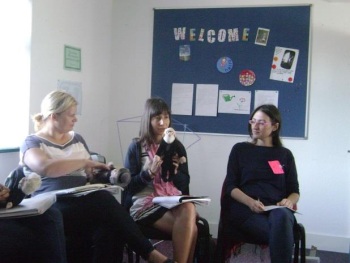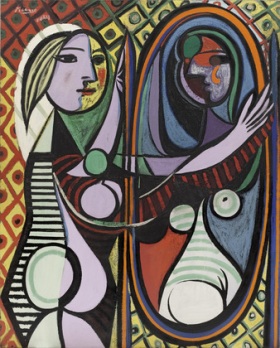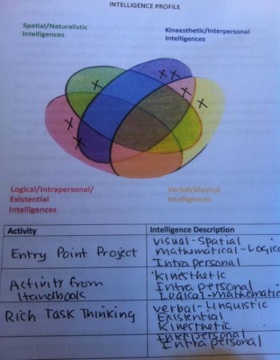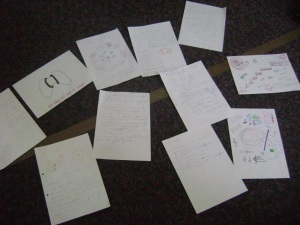An Unforgettable Experience: Participation in an EU Project on Multiple Intelligence
Bonnie Tsai, France
Bonnie Tsai is a free lance trainer. She regularly runs Teacher Training courses for Pilgrims in Canterbury England. She has trained in such humanistic approaches as Suggestopdia with Dr. G. Lozanov, and is a Master Practioner in N.L.P. She trained in coaching skills with Robert Dilts. She holds a degree from Harvard University Graduate School of Education where she trained with Drs. Howard Gardiner and David Perkins at The Harvard Graduate School of Education. She is a CELTA and CETLYL trainer. She is co-author of Business English Recipes with Judith Irigoin and Creative Resources with Judit Feher. Her main area of interest is the many different ways people can learn effectively.


Menu
Introduction
The Project
The Pilgrims Course
The group
Feedback from the group
Conclusions
References
In 2010 I was asked to participate in an EU Project entitled, “Intelligent Pathways for Better Inclusion.” In this article I will just call the project “Inpath.” In the beginning I was told it was a project about Multiple Intelligence. Those of you, who know me, will recognize that this is one of my areas of expertise and that I have run many summer courses around Multiple Intelligence for Teachers, so I was excited about carrying M.I. further afield.
Later however I learned this project concerned people who were social worker or who worked in some branch of social services. There were six partner countries involved in the project: the U.K, Spain, Portugal, Rumania, Germany and Italy. We had 5 meetings to attend in each of the partner countries except the U.K. This was because Pilgrims in the UK was slated to run a one week course on integrating M.I. into training social workers in 2013. This was to be Pilgrims’s role in the project and I would run the one week course.
During the three years the project ran, we created four newsletters, created a web site, and a Facebook account, which has had an enormous success. Different partners were responsible for each aspect of the project.
For example each of us had to do a series of needs analysis. There were two types of need analysis procedures: a face to face discussion based mainly on what people wanted or expected in the handbook and in a course on M.I. The second was a printed needs analysis form to fill in and send back to the Inpath partners in their country. This was frankly a low point for me because I realize how little some people knew about M.I. beyond the names of the intelligences and how many mis-conceptions there were. It was however very useful to know what was needed and in which direction we should move.
Another big part of the project was the creation of a handbook by our Italian partner represented by Paola Nicoli. As it turned out she and I were the only ones who knew anything about M.I.
In 2012 she attended part of a Multiple Intelligence course held at Pilgrims. At that point we decided that the handbook would be divided into two parts. She would do the theoretic part and I would do the practical activities. This handbook will be placed online by Pilgrims where you can download it and hopefully learn more about M.I. and activities you can use in your particular field.
We still need to produce a teacher’s manual and DVD, which will be completed in November 2013. Plus there will be 4 workshops in Rumania, Spain, Portugal and Italy to validate the final version of the Handbook in October and November 2013. This will mark the end of the project.
So what was it like to work on an E.U. project for the first time? The strong points for me were the opportunity to work with the partner countries. However the partners were all doing quite different work and courses than the ones I do at Pilgrims. Three of our partners work in universities and have graduate assistants to work on the project with them and two of our partners work entirely on E.U. projects often up to eight at one time.
The other part which threw me in the beginning was filling in spread sheets and finding 100 people I could send the newsletter to. While it was easy to get 100 contacts from people who had contacted pilgrims at some point often e-mails bounced and so I had to find more names. What did fascinate me was the number of people who responded to the newsletters and remarked how useful it was that Pilgrims were moving into new areas.
There were four pillars to the project
- Parenting
- Family budgeting
- Learning to Learn
- Job seekers
Keeping in mind that the social workers were working with adults who were living below the poverty belt and were often unable to cope successfully with issues concerning daily survival, this was certainly a big challenge. The big question was how could M.I. work in these kinds of situations? Most of my experience with M.I. had been in schools which had chosen to use M.I. and where there was a high standard of success amongst the students. Here just the opposite was true. Most of the adults under the care of social services had been unsuccessful in school and had dropped out as soon as it was possible. And then I had a thought. Years ago I had been in touch with the University of the First Age in Birmingham, England.
The University of the First Age aims to create enjoyable learning challenges that enrich lives, illiteracies aspiration and promote achievement for young people aged 5 – 25.
They do this through creating a learning network that young people can belong to anywhere, at any time that develops learning and leadership skills for life. In doing this, they create lasting relationships with schools, communities and with parents, so they can work together to develop innovative learning activities both outside and within the school day.
Being part of a ‘university’ in early life helps to raise aspirations and increase the likelihood of young people going on to Further and Higher Education.
The thing that was important to me in studying UFA was that they were working on projects of a practical nature which were built around what was useful outside the classroom. These included creating a public garden and creating, giving and calculating results from the survey about a project to add a runway to the local airport. And UFA was using M.I. in their programs. This follows Howard Gardner’s definition of intelligence as being able to create something of value to society.
I realized that this project was about thinking out of the box. This I found exciting and convinced me that this E.U. project could be both useful and could change the way we worked with this large group of people.
One big challenge was with the other partners in the Inpath group. As I said before except for Paola Nicoli from Italy none of the other partners knew much about M.I. My big regret is that I didn’t insist on a short interactive workshop on M.I. for the other participants. I think this would have eased the way for the entire group. As it was we spent a long time in discussions about what M.I. was about and how it could be used with this particular group of people.
I also wonder about the effective feedback on the regional workshops led by social workers who knew little or nothing about M.I. except what they read in the draft version of the handbook. I suspect they did the activities without necessary using or understanding the connections to M.I. The Italian partners did do quite a bit of revision work on the theoretic part of the handbook based on the feedback we received from both the trainers and the participants. Also the feedback overall was highly positive so we moved on to organizing the course at Pilgrims.
I started working on the course almost two years ago. I decided that it would be based on the following aspects of Multiple Intelligence. The points I decided to take into account followed very closely the ones laid out in the handbook. In a sense I was testing the handbook by trying it out because in a way it had been compromise between Paola and me.
- The nine intelligences and their definition
- How they work together to create something of value
- Using the different intelligences to bridge leaners from their stronger intelligences to their weaker ones.
- Recognizing their own intelligence profile
- Through observation learning how to recognize and build up an intelligence profile for their learners.
- Creating a M.I. activity using Rich Text Thinking from the handbook.
- Creating a wiki with a four hour course using one of the pillars of the projects as a theme..
I introduced the nine intelligences by using a metaphor called “The Land of Smart.” This metaphor uses a landscape with different elements representing the nine intelligences.
So there was:
The Sun
Some clouds
A mountain range
A village
A lake
A field of grain
A forest
A river
A bench in the shape of a question mark
This really worked well and had very positive feedback from the group. Besides the visual/spatial and naturalistic intelligences, comparing the intelligences to some well-known things enabled them to make connections and thus remember the intelligences and their meaning.
At the last minute I decided to bring out my M.I. dolls. I have one which represents the main characteristics of each intelligence. For example: think about Albert Einstein. People often think, ah Albert Einstein that is logical/mathematical. But once they thought about it, they understood it was more, much more than just one intelligence. And so we added visual/spatial, intrapersonal, interpersonal, and existential to Mr. Einstein.

Discussing Sigmund Freud’s intelligence profile.
In the last session of day 1, the group experienced working on the Learning to Learn pillar of the Inpath project. They were given a choice as to which intelligence they wanted to work with and if they wanted to work with someone or alone. As an observer this was amazing. Some of the participants without knowing what they would be doing with a particular intelligence, quickly choice which one they wanted to work with while others found this difficult. One participant decided that she would work alone on the musical intelligence. Two participants couldn’t choose an intelligence to work with and one of them obviously wanted to work alone. Interestingly enough they ended up with an activity built around the interpersonal intelligence and they both found this very difficult.
Their presentations based on Learning to Learn were fascinating to observe. The woman working on the musical intelligence used the logical and intrapersonal approach to explain how she had chosen five pieces of music to symbolize five of the intelligences. The pair who chose the visual/spatial intelligence had the task of creating a college on M.I. They took a lot of time to plan and discuss how they would do this and even created a modal before they created their college. It was very clear and simple and they were certainly using the logical/mathematical intelligence to a great extent.
The pair who had the existential intelligence were a little perplexed as to how they could present their activity. They finally presented it using the kinesthetic intelligence. In the end however this provoked an active discussion in the group which used the existential, interpersonal, and linguistic intelligence.
This was the first stage in their recognition of their own intelligence profile and how they could use their stronger intelligences to reach their weaker ones.
The next day, I gave them my lesson plan from day 1. They filled in the intelligences they thought they used or came in contact with the day before. Of course I emphasized that they didn’t have to use each intelligence in every lesson or client contact. But that it was important that none be left out entirely. I also explained that their choses of activities would depend a lot on their own intelligence profile. To round off this session we looked at a painting by Pablo Picasso and decided which intelligences he used.

When we received the feedback from the first series of national workshops to test the draft version of the handbook, the other partners insisted on the fact that the social workers and trainers running these workshops had no idea how to observe a group in order to create an intelligence profile. So this was something I added to the Inpath course quite late in its creation. Fortunately I had some video clips from Harvard which were perfect for observation. I chose two which seemed appropriate. The first one was on lesson built around migration. We worked together to build up an observation on intelligences used but also critical thinking skills, which is an essential part of M.I. The second film showed a class working on Children’s Human Rights. The group watched the film and wrote up an observation on the intelligences and the critical thinking skills used.
Parallel to this I wrote up my own observation report every evening on each member of the group sighting what I had observed but also comments I had heard them back. By now it was becoming clearer and clearer some of the primary intelligences in the group. I had someone with a strongly kinesthetic intelligence and another person with a dominant logical/mathematical intelligence. The other thing that surprised me was the strong intra- personal intelligences in the group as opposed to weaker interpersonal ones. I was on the way to creating their intelligence profile.

An intelligence profile based on observation over one week.
A big part of the course was using activities from the Handbook and using the Rich Task Thinking activity also in the handbook to create an lesson using several intelligences. The three activities they were given to choose from were one 1) on logical thinking, 2) on creative thinking and 3) on problem solving. I had removed the introductions to the activities so that they couldn’t see what had been written about the intelligence entry points used so each group was free to develop it as they wished.
In many ways this was the high point of the week because without exception they were able to create viable and useful M.I. lessons. This meant they were able to analysis a piece of material and using several of the intelligences “make bridges” from stronger intelligences to weaker ones. In this way participants in courses were able to use their stronger intelligences to work with what may have been weaker ones. By this time they were becoming more and more aware of their own intelligence profiles and so were more aware of why it was necessary to use their weaker ones, which they had usually left out of their lessons.
At the, end of the day I told them a story, called His First Flight about a sea gull learning to fly despite his fear. For those of you who have been to Canterbury, you will probably remember the sea gulls flying around.
From here they were ask using a piece of paper and coloured pens if they wanted to express what they had learned so far that would enable them to take their first flight using Multiple Intelligence.

Different ways participants represented their first flight.
What was becoming interesting at this point is that three of the participants found joy and pleasure in working with the visual/spatial intelligence. This was new to them. This is one of the reasons M.I. is so important. It gives learners the opportunity to choose different intelligences to express their understanding and at the same time allows them to develop their potential in different areas.
The week ended with a project of setting up a wiki to be used by the group in the future to share information and to keep in contact. Participants divided into three groups and chose one of the four pillars they wanted to work on. Their task was to design a four hour lesson suitable for their pillar.
They choose Parenting, Training the Trainer, and Learning to Learn. They were given one session before lunch to create their lesson. The three groups worked very differently. There were four Portuguese social workers on the course who chose to work in Portuguese. When I visited the group they switched to English so that I could understand. They were working together as a team and had lots of ideas. Another group was made up of participants with mixed professions, social workers, teachers, and one language teacher. They were obviously having a hard time coming to an agreement as to what they wanted to include in their lesson. I realized that while the time was running out, they were still in the early stages of the lesson planning. Meanwhile the third group had finished and posted their lesson on the wiki.
Finally I told the second group to post what they had and that they could go back into the wiki and complete it later. So far this has not happened. I must say that they did all they could to finish-even skipping lunch. Normally I think having people working within a group with different intelligence strengths is an advantage. Here I think it was more about the people they were working with and the differences in the kind of lesson that would be appropriate. The group that finished so quickly worried me because I had to wonder if they were creating something new or were using something they had already used. The answer to this enigma came on the last day.
While there were 70 people who applied for the course, only 11 received grants. Before the course started I created a drop box with articles and video clips about M.I. I asked them also to think about their aim for the week and to write them out on a piece of paper and to make a symbolic drawing to represent what they had written. Unfortunately only three participants did this. There were also some of them who had never heard of drop box and didn’t understand how it worked. So these people received what I could send by e-mail.
Therefore I knew little about the group before they arrived at Pilgrims. What surprised me was that there was an even division between social workers and primary and secondary teachers. There was one psychiatrist and a German teacher in the group. I wondered how this was going to work on the first day with a course designed for social workers. In fact it worked very well. Except for the instance with the wiki activity, they actually did on the whole work well together. At any rate there was little or no complaint about the programme. The teachers remarked that while they were not social workers, they needed this kind of course to find solutions for students who were living with the same problems as the social workers were dealing with.
Another issue which divided the group was more theory vs. more activities. It is true I concentrated more on the theory and how to use it than activities. One morning I did do some activities which they all enjoyed. But I wanted to keep the aim of the course in mind, which was that they could use M.I. in a useful way once they were back in their own countries.
Since they all received a copy of the handbook, I felt there were plenty of activities divided into the four pillars of the Inpath project.
There was a big gap in the groups’ competence in English ranging from A1 to C1. They seemed to be able to help each other and there was never an instance where someone couldn’t do something because of the language bearer.
However another point that came back in the feedback at the end of the course was that instructions lacked clarity. I felt this was due more to the way I gave instructions rather than understanding the instructions. I tended to tell them what to do but not how to do the activity. I wanted them to have a choice and to realize there was not necessarily a right or wrong way to do an activity.
This was demonstrated in the variety of ways that individual participants interpreted the instructions and produced beautiful work depending on their intelligence strengths. For some of the teachers in the group this was a new idea. It was illustrated very well by a pair that created intelligence stations in the classroom whereby students could move around and select different intelligences they wanted to work with to complete an activity.
At the end of the course they were given a drawing of a mandala and a box of art material. They were asked to use the mandala design to show their understanding of M.I. The results were wonderful and to hear them comment on their Mandela with each other was enlightening.
Remember my comments about the group that finished their four hour lesson for the wiki? The answer to my doubts came during this activity. As soon as I finished giving instructions for mandala, the participant whose group had finished the wiki quickly, dived in, grabbed a mandala and a pair of scissors. She quickly cut away the outer parts of the Mandela and worked with the center. She explained that was her way of working. She got rid of what was not necessary and worked with what was important. This explained everything about how she learned. And what was interesting was how aware she is of how she learns and completes tasks. This seems to me to be an excellent example of the intrapersonal intelligence and the way it allows us to know ourselves.
On the last afternoon of the course, the participants divided into three groups to write me a letter about the course. Here are some of their comments.
“We all agree that we look at ourselves in a different way now.”
“We would like to go on learning about these things and we would like to meet again.”
“If possible we would like to meet Howard Gardner.”
We did a lot of games, pair and group work. Each task was delivered with the purpose to understand M.I. better.
“The course was very demanding and a bit tiring.”
“We had to learn to think in new ways.”
“We found new friends and had a good time.”
“We learned a lot about ourselves and others.”
“We are grateful to have the chance to surprise ourselves-one to use our brains in an integrated way and two-we had the chance to know each other without feeling pressed.”
“We used skills we didn’t know we had.”
We discovered how to explore and know ourselves in a multitude of ways.”
The Inpath group had their last meeting in Rumania one week after the Pilgrims Inpath Course ended. I was very excited to share my experiences with the group. I realized the flexibility of the Multiple Intelligence Theory and how it could be used successfully in many different fields. This is keeping in mind that Howard Gardner never intended it to be a methodology. It is thanks to his colleagues at Project Zero that it has developed into a practical, easy to use methodology that goes far beyond the nine intelligences.
It was also great to see how comfortable the Inpath partners had become with M.I. There was evidence of real understanding of the theory and its practical application. My partners had had to translate all the documents associated with the project into their national languages and this has certainly increased their understanding of M.I.
Each partner will print and give out 100 copies of the handbook and 100 C.D.’s. These will enable us to spread our work beyond the workshops and the one week course held at Pilgrims. We are also preparing a trainer’s handbook.
I also believe there is a whole area of teachers working in deprived areas of Europe who will find this kind of training relevant to making their classes more meaningful and useful.
I would also like to recognize the partners who worked consistently and as a team to make this project successful.
His First Flight. by Liam O'Flaherty
Gardner, Howard (1991). The Unschooled Mind: How children think and how schools should teach. New York: Basic.
Intelligences Reframed: Multiple Intelligences for the 21st Century. New York: Basic, 1999.
The Disciplined Mind: What All Students Should Understand. New York: Simon &Schuster, 1999.

Please check the Teaching English Through Multiple Intelligences course at Pilgrims website.
Please check the Creative Methodology for the Classroom course at Pilgrims website.


|